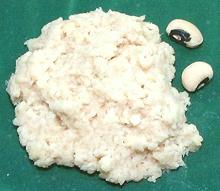
Oleleh Beans
Africa, West - Oleleh, Ohleleh
Effort:
Sched:
DoAhead:
**
10 hrs
Must
|
Oleleh BeansAfrica, West - Oleleh, Ohleleh | ||||
| Makes: Effort: Sched: DoAhead: |
2 cups ** 10 hrs Must |
A standard ingredient in much of sub-Saharan Africa. It's used for a dish called Oleleh in Sierra Leone and Moi Moi in Nigeria, as well as in many sauces for chicken, fish and meat. | |||
| Black Eyed peas are the beans to use because they are native to Africa - all other familiar beans came from the Americas. 1 cup dry beans will yield 2 cups of finished paste. If you need less (or more) just use half the volume of dried beans for the amount you want. | |||||
|
1 |
c |
Black Eyed Peas, dry |
Make - (10 hrs - 45 min work)
|